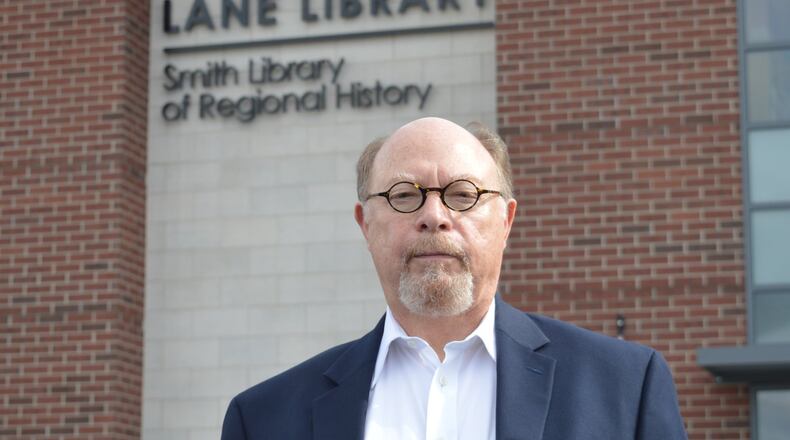The Butler County library system has branches in Fairfield, Oxford and Hamilton.
He is proud of the Oxford Lane Library building which opened in September 2015 during his tenure on the board as the newest in the system but is equally proud of all the Lane locations and what they offer to residents of Hamilton, Fairfield and Oxford.
“It’s an honor to be a member of the board of trustees,” Ellison said. “Personally, I have always been a library person. My mother was a teacher in a small mining town in Alabama. She was on the board of trustees of the library and I always went to hang out at the library after my music lessons. I have always been a strong, strong proponent of public libraries. I am a devotee of this kind of thing.”
He recalls many pleasant hours spend in the Carl Elliott Regional Library in Jasper, Alabama. Even though in those early years, he said he always saw his future in music, the library was always an opening to the world, eventually fueling an interest in history.
“I was always kind of a curious kid. The library was an opportunity,” he said.
That opportunity brought him the work of many writers, including Richard Wright, a black writer from northern Mississippi who told of a librarian who gave him books, despite segregation, prompting Ellison to say he could appreciate what Wright had to say.
Part of the 150th celebration of the Lane Library system was bringing writer David McCullough to speak at Miami University Hamilton where he told of how important public libraries were to him growing up.
“He was a perfect guest for us to bring,” Ellison said. “We need people to be literary and read for libraries to be successful.”
A library was so important to Thomas Jefferson he designed the campus of the University of Virginia with the library as the central point of the campus, Ellison said.
That same sense of the importance of a library was shared by Clark Lane, a well-known figure in Hamilton, who built an octagonal-shaped home and then an octagonal-shaped library across the street. His library opened in October 1866. Ellison referred to him as “the southwestern Ohio version of Andrew Carnegie” adding, “He liked to help people.”
He gave his library to the city of Hamilton and it eventually grew to serve three cities.
“It is really a very successful public library system. It’s something the board and library trustees take very seriously. We had one of the earliest Bookmobile systems in the state to reach out to communities all over the region,” Ellison said. “The Lane system, in 2016, was the highest circulating library system in the state. We are number one in the state and there are some much bigger libraries in the state.”
Although the Lane Library system started in the 1860s, it has not stayed rooted in those years, but has expanded to meet patrons’ needs, offering technology, children’s areas, teen areas, meeting rooms, expanded offerings with partnerships with other library systems and much more. All of that is a source of pride to Ellison, who sees such growth as offering community members more than just the internet alone can.
The expanded services and conveniences were evident in the new Oxford library the day it opened.
“On the first day, we thought people would come and tour but the minute the ribbon was cut, students came in and used the technology. They wanted a place to work,” he said. “The community reception of the library has been wonderful.”
He said they had first looked at expanding the old location but it was landlocked and parking was not sufficient. They embarked on a series of public meetings to hear what residents wanted and where they thought was the best location, starting with 17 possible sites and narrowing it down to their South Locust Street location.
Not only was the new location fitted with new amenities, bigger space and plenty of parking, there was a bow to the past with the inclusion of the two murals from the old Miami-Western Theater, the large globe formerly housed in Miami’s Shideler Hall and several other pieces of Oxford history.
Also housed in the building is the Smith Library of Regional History, which is especially close to Ellison’s heart with his love of history.
“A research library is not typical to have as a unit but by having a research library we are preserving and providing access to the history of the region,” he said.
Prior to the Oxford opening, the previous addition to the system was the Lane Community Technology Center in downtown Hamilton, which opened in 2013. It came about because of the heavy demand on computers in the main library facilities, but has become so much more with the addition of 3D printers and Ellison said they are about to take on virtual reality.
Fairfield’s concept of a new city center, called the Village Green, led to discussions of moving that community’s Lane Library to that site giving it more prominence and it opened in September 2001.
Last year’s sesquicentennial book brought together the efforts of many writers to tell the entire Lane story and Ellison found it a labor of love serving as its editor.
“A lot of people took a strong interest in the sesquicentennial book. I had the opportunity—with assistance—to edit and put it together in a simple narrative. The contributors did a good job,” he said. “It is a good history of the organization, not just a promotional piece. It was written to be a genuine history over 150 years.”
He praised the staff of the library system as very capable and innovative, thinking of the needs of the community they serve and noted the Bookmobile is going strong, allowing them to serve and even wider area.
About the Author
